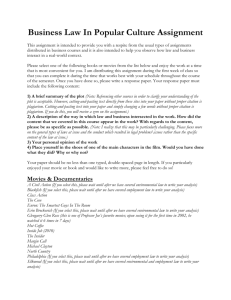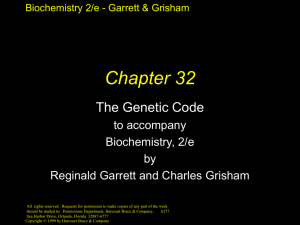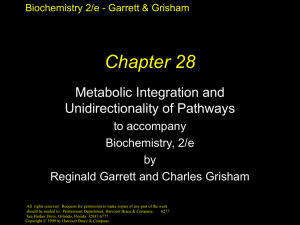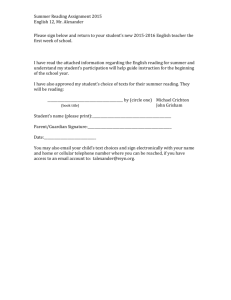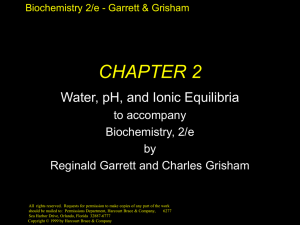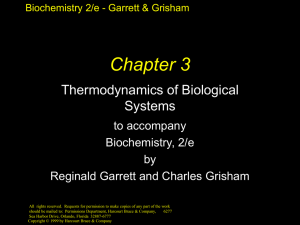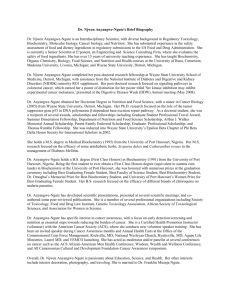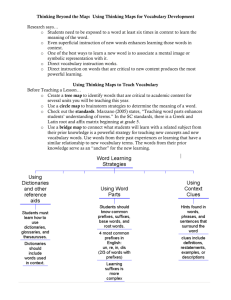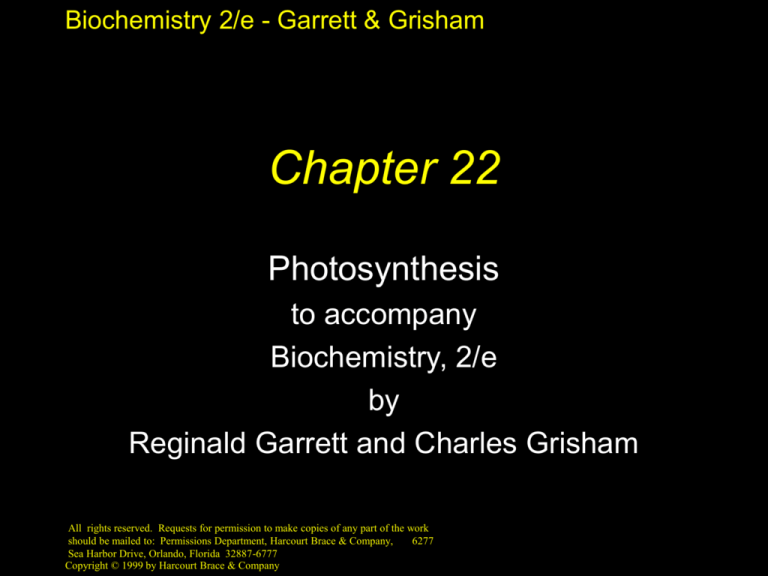
Biochemistry 2/e - Garrett & Grisham
Chapter 22
Photosynthesis
to accompany
Biochemistry, 2/e
by
Reginald Garrett and Charles Grisham
All rights reserved. Requests for permission to make copies of any part of the work
should be mailed to: Permissions Department, Harcourt Brace & Company,
6277
Sea Harbor Drive, Orlando, Florida 32887-6777
Copyright © 1999 by Harcourt Brace & Company
Biochemistry 2/e - Garrett & Grisham
Outline
• 22.2 The Photoreactivity of Chlorophyll
• 22.4 The Z Scheme of Photosynthesis
• 22.7 Light-Driven ATP Synthesis Photophosphorylation
• 22.8 Carbon Dioxide Fixation
• 22.9 The Calvin-Benson Cycle
• 22.10 Regulation of Carbon Dioxide Fixation
• 22.12 The C-4 Pathway of CO2 Fixation
Copyright © 1999 by Harcourt Brace & Company
Biochemistry 2/e - Garrett & Grisham
The Sun - Ultimate Energy
•
•
•
•
1.5 x 1022 kJ falls on the earth each day
1% is absorbed by photosynthetic organisms
and transformed into chemical energy
6CO2 + 6H2O C6H12O6 + 6O2
1011 tons (!) of CO2 are fixed globally per year
Formation of sugar from CO2 and water
requires energy
• Sunlight is the energy source!
Copyright © 1999 by Harcourt Brace & Company
Biochemistry 2/e - Garrett & Grisham
Photosynthesis
•
•
•
•
General Aspects
Photosynthesis occurs in thylakoid membranes
of chloroplasts - structures involving paired
folds (lamellae) that stack to form "grana"
The soluble portion of the chloroplast is the
"stroma"
The interior of the thylakoid vesicles is the
"thylakoid space" or "thylakoid lumen"
Chloroplasts possess DNA, RNA and
ribosomes
Copyright © 1999 by Harcourt Brace & Company
Biochemistry 2/e - Garrett & Grisham
Copyright © 1999 by Harcourt Brace & Company
Biochemistry 2/e - Garrett & Grisham
Photosynthesis Consists of
Both Light Reactions and Dark
Reactions
• The light reactions capture light energy and
convert it to chemical energy in the form of
reducing potential (NADPH) and ATP with
evolution of oxygen
• The dark reactions use NADPH and ATP to
drive the endergonic process of hexose sugar
formation from CO2 in a series of reactions in
the stroma
Copyright © 1999 by Harcourt Brace & Company
Biochemistry 2/e - Garrett & Grisham
Copyright © 1999 by Harcourt Brace & Company
Biochemistry 2/e - Garrett & Grisham
Water is the electron donor
•
•
•
•
for Photosynthetic NADP+ Reduction
Equations 22.2 and 22.3 describe the light and
dark reactions in green plants, respectively!
Equation 22.4 provides a more general version
Photosynthetic bacteria use H2S, isopropanol or
other oxidizable substrates
The O2 we depend upon depends in turn on large
amounts of photosynthesis on the earth!
Copyright © 1999 by Harcourt Brace & Company
Biochemistry 2/e - Garrett & Grisham
Chlorophyll
•
•
•
•
Photoreactive, isoprene-based pigment
A planar, conjugated ring system similar to porphyrins
Mg in place of iron in the center
Long chain phytol group confers
membrane solubility
Aromaticity makes chlorophyll an
efficient absorber of light
Copyright © 1999 by Harcourt Brace & Company
Biochemistry 2/e - Garrett & Grisham
Copyright © 1999 by Harcourt Brace & Company
Biochemistry 2/e - Garrett & Grisham
Copyright © 1999 by Harcourt Brace & Company
Biochemistry 2/e - Garrett & Grisham
Copyright © 1999 by Harcourt Brace & Company
Biochemistry 2/e - Garrett & Grisham
The Photosynthetic Unit
Many chlorophylls but only a single reaction
center
• The "unit" consists of several hundred
light-capturing chlorophylls plus a pair of
special chlorophylls in the "reaction center"
• Light is captured by one of the "antenna
chlorophylls" and routed from one to the
other until it reaches the reaction center
• See Figure 22.9
Copyright © 1999 by Harcourt Brace & Company
Biochemistry 2/e - Garrett & Grisham
Copyright © 1999 by Harcourt Brace & Company
Biochemistry 2/e - Garrett & Grisham
Eukaryotic Photosystems
•
•
•
•
PSI (P700) and PSII (P680)
All chlorophyll is part of either LHC, PSI or
PSII
PSI absorbs at 700 nm
PSII absorbs at 680 nm
Chloroplasts given light at 680 and 700 nm
simultaneously yield more O2 than the sum
of amounts when each is used alone.
Copyright © 1999 by Harcourt Brace & Company
Biochemistry 2/e - Garrett & Grisham
Copyright © 1999 by Harcourt Brace & Company
Biochemistry 2/e - Garrett & Grisham
What does each photosystem
do?
See Figure 22.11
• PSII oxidizes water (termed “photolysis")
• PSI reduces NADP+
• ATP is generated by establishment of a
proton gradient as electrons flow from
PSII to PSI
Copyright © 1999 by Harcourt Brace & Company
Biochemistry 2/e - Garrett & Grisham
Copyright © 1999 by Harcourt Brace & Company
Biochemistry 2/e - Garrett & Grisham
The Z Scheme
An arrangement of the electron carriers as a chain
according to their standard reduction potentials
• PQ = plastoquinone
• PC = plastocyanin
• "F"s = ferredoxins
• Ao = a special chlorophyll a
• A1 = a special PSI quinone
• Cytochrome b6/cytochrome f complex is a proton
pump
Copyright © 1999 by Harcourt Brace & Company
Biochemistry 2/e - Garrett & Grisham
Copyright © 1999 by Harcourt Brace & Company
Biochemistry 2/e - Garrett & Grisham
Copyright © 1999 by Harcourt Brace & Company
Biochemistry 2/e - Garrett & Grisham
Oxygen evolution by PSII
requires accumulation of four oxidizing
equivalents
• PSII (P680) cycles through five
oxidation states
• 1 e- is removed in each of four steps
• Fifth step involves H2O oxidized to
O2 + 4H+
Copyright © 1999 by Harcourt Brace & Company
Biochemistry 2/e - Garrett & Grisham
Copyright © 1999 by Harcourt Brace & Company
Biochemistry 2/e - Garrett & Grisham
Copyright © 1999 by Harcourt Brace & Company
Biochemistry 2/e - Garrett & Grisham
Structures of Reaction
Centers
•
•
•
•
R. viridis is a model!
Membrane proteins (as always) are resistant to
crystallization (and X-ray diffraction studies)
Deisenhofer, Michel and Huber solved R.viridis
structure in 1984 (Nobel Prize same year!)
Four peptides: L, M, H and cytochrome
No electron transfer appears to occur through M
• See Figures 22.16, 22.18
Copyright © 1999 by Harcourt Brace & Company
Biochemistry 2/e - Garrett & Grisham
Copyright © 1999 by Harcourt Brace & Company
Biochemistry 2/e - Garrett & Grisham
Copyright © 1999 by Harcourt Brace & Company
Biochemistry 2/e - Garrett & Grisham
Copyright © 1999 by Harcourt Brace & Company
Biochemistry 2/e - Garrett & Grisham
Copyright © 1999 by Harcourt Brace & Company
Biochemistry 2/e - Garrett & Grisham
Copyright © 1999 by Harcourt Brace & Company
Biochemistry 2/e - Garrett & Grisham
The Quantum Yield
Amount of O2 evolved per photon
• Four photons per reaction center 8 total - drive the evolution of 1 O2,
reduction of 2 NADP+, and the
phosphorylation of 2 and 2/3 ATP
Copyright © 1999 by Harcourt Brace & Company
Biochemistry 2/e - Garrett & Grisham
Photophosphorylation
Light-Driven ATP Synthesis
• Electron transfer through the proteins of
the Z scheme drives the generation of a
proton gradient across the thylakoid
membrane
• Protons pumped into the lumen of the
thylakoids flow back out, driving the
synthesis of ATP
• CF1-CFo ATP synthase is similar to the
mitochondrial ATP synthase
Copyright © 1999 by Harcourt Brace & Company
Biochemistry 2/e - Garrett & Grisham
Copyright © 1999 by Harcourt Brace & Company
Biochemistry 2/e - Garrett & Grisham
Cyclic Photophosphorylation
ATP without NADPH!
• The photo-excited electron removed
from P700 returns to P700 in a pathway
indicated by the dashed line in Figure
22.12
• Cyclic photophosphorylation depends
only on PSI, not on PSII
Copyright © 1999 by Harcourt Brace & Company
Biochemistry 2/e - Garrett & Grisham
Copyright © 1999 by Harcourt Brace & Company
Biochemistry 2/e - Garrett & Grisham
Carbon Dioxide Fixation
A unique ability of plants, algae, etc.
• Melvin Calvin at Berkeley in 1945 showed
that Chlorella could take up 14CO2 and
produce 3-phosphoglycerate
• What was actually happening was that CO2
was combining with a 5-C sugar to form a
6-C intermediate
• This breaks down to two 3-P glycerates
Copyright © 1999 by Harcourt Brace & Company
Biochemistry 2/e - Garrett & Grisham
Ribulose-1,5-Bisphosphate
•
•
•
•
•
The CO2 Acceptor
Fixation is accomplished by ribulose bisphosphate
carboxylase (oxygenase), aka rubisco
Probably the world's most abundant protein
Study the mechanism in Figure 22.24
Rubisco is activated when carbamylated (CO2
added to Lys-201) and with Mg bound
RuBP (substrate!) is inhibitor and must be
released from inactive rubisco by rubisco
activase. Carbamylation and Mg then activate.
Copyright © 1999 by Harcourt Brace & Company
Biochemistry 2/e - Garrett & Grisham
Copyright © 1999 by Harcourt Brace & Company
Biochemistry 2/e - Garrett & Grisham
Copyright © 1999 by Harcourt Brace & Company
Biochemistry 2/e - Garrett & Grisham
The Calvin-Benson Cycle
•
•
•
•
•
aka The Calvin Cycle
The set of reactions that transform 3-Pglycerate into hexose sugar
The only net CO2 fixation pathway in
nature
A disguised gluconeogenesis pathway!
With some pentose phosphate pathway
reactions thrown in....
See Figure 22.25
Copyright © 1999 by Harcourt Brace & Company
Biochemistry 2/e - Garrett & Grisham
Copyright © 1999 by Harcourt Brace & Company
Biochemistry 2/e - Garrett & Grisham
Copyright © 1999 by Harcourt Brace & Company
Biochemistry 2/e - Garrett & Grisham
Regulation of CO2 Fixation
Activities of Calvin cycle enzymes (in the
stroma!) are coordinated with
photosynthesis
• Three effects:
– Light-induced pH changes
– Light-induced generation of reducing
power (reduced ferredoxin and NADPH)
– Light-induced Mg2+ Efflux from Thylakoids
Copyright © 1999 by Harcourt Brace & Company
Biochemistry 2/e - Garrett & Grisham
Copyright © 1999 by Harcourt Brace & Company
Biochemistry 2/e - Garrett & Grisham
Copyright © 1999 by Harcourt Brace & Company
Biochemistry 2/e - Garrett & Grisham
Copyright © 1999 by Harcourt Brace & Company
Biochemistry 2/e - Garrett & Grisham
The C-4 Pathway for CO2 Fixation
•
•
•
•
aka the Hatch-Slack Pathway
Not an alternative to Calvin cycle, nor even a net
CO2 fixation pathway
Rather, it is a CO2 delivery system, which carries
CO2 from the O2-rich leaf surface to interior cells
where O2 won't compete in the rubisco reaction
Oxaloacetate and malate are the CO2 transporters
Read about Crassulacean acid metabolism
Copyright © 1999 by Harcourt Brace & Company
Biochemistry 2/e - Garrett & Grisham
Copyright © 1999 by Harcourt Brace & Company

